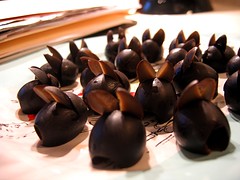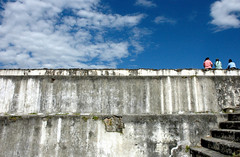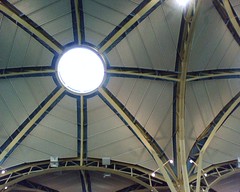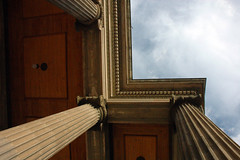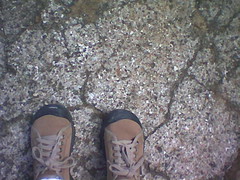Everyone's talking about how cold it is in Houston -- somewhere in the 30s.
When I left Chicago earlier today it was 7 degrees.
You could say that I lack sympathy, but that would be putting it mildly.
Posting by cameraphone from Katy, TX
Wednesday, January 31, 2007
shoot the moon
I realize it has everything to do with the fact that I don't have an adequate lens for taking shots of the moon (and no, I don't suppose this here cameraphone is going to quite manage to close that gap), but the moon is one of those things that I always shoot shyly, like I did A.G. -- a tall quiet kid that I had a raging crush on in 9th grade but never got up the courage to talk to -- when I was the photographer for our Jr High School paper and he was warming the bench during some basketball game that I was assigned to cover.
I shot *around* him a hundred and a half ways, but I never managed to shoot him directly -- and as a result, in all the shots that I took, he fell away to the horizon. My heart ached when I saw those shots developed (even though I knew what was on that roll) the same way it does when I shoot the moon.
Shot en route to Houston.
Posting by cameraphone from Katy, TX.
this old house
So it seems that once you get started with this whole belly button thing, umbilicus start crawling out of the woodwork. Let me explain:
Paid a visit to the Field Museum last night to hear about an upcoming visit from a Maori delegation from New Zealand. There are three Maori meeting houses outside of New Zealand: Hamburg and London each has one, Chicago has the third.
The delegation is coming to talk about the third.
A few years back there was a ceremony in which the house was dusted off and reinstalled the right way -- barrier glass removed, weavings restored to the walls, form rebuilt so that the central beam slants downward toward the back of the structure the way it was intended. The whole of the house – with its elaborately carved beams – resembles the human form – carved faces and arms stretched wide and welcoming at the opening, central beam running like a spine through the house. The Maori believe that a meeting house is a living thing where the ancestors reside -- and to stay alive and well it must be used, and it must touched.
Seems like we were blowing it for awhile at the Field – the house was tucked away behind glass where it couldn’t be touched, couldn’t be used. An attempt was made to remedy that with the reinstallation in the early ‘90s – however, we haven’t done the best we could do to put it to good use. It sits quietly on the second floor of the museum, usually occupied by a single attendant whose responsibility is to tell the story of the house – how it is used and what it means. All of this came about through conversation with the Maori of Tokomaru Bay in New Zealand, where the house originated (it was sold to a German fellow in the early 1900s – Chicago bought it from him).
The last time I visited the house was on the tail end of experiencing an exhibit of photography from Auschwitz, which was installed nearby, and was deeply unsettling. I stepped into the house, found a little niche along the wall, and just sat there awhile. People came and went, and before too long I felt calmer, quieter. Not resolved after what I had seen, but better than before. I could tell the house was Maori because I was vaguely familiar with that style of woodcarving, but I didn’t realize then what a rarity it was.
For a time there was a conversation about repatriating the house, and so the Field Museum sent a delegation to New Zealand to talk to the original community about what should be done. It was agreed that if certain steps were taken that it could live and be well at the Field. As the delegation was leaving an older Maori woman, known as Aunt Ida, handed Dr. John Terrell of the Field a small carved wooden box and said: “When the house is ready, you’re going to need this.” Terrell asked if he could look inside and she said of course – inside he found an infant’s umbilicus. It’s now interred in the house – in a hidden spot.
Terrell explained, when he told this story, that it’s the umbilicus that brings the house alive.
What he didn’t say, but what I thought immediately, was “Yeah, baby: belly buttons.”
Anyway, the conversation about repatriation has reared up again, and the Maori will be visiting again this coming April to make sure that Ruatepupuke II (the name of the house) is alive and well under the care of the Field Museum. Clearly the folks at the Field feel that they have done well by the structure as conservators, but there was much conversation tonight about whether all has been done that can be done to put it to good use – food and drink is an important part of that use, as is activity, music, and dance. All things that it doesn’t see much of on the second floor of the museum.
Time will tell if we, entrusted as the Chicago marae, can pull this thing off -- or if the house will be going home soon.
Paid a visit to the Field Museum last night to hear about an upcoming visit from a Maori delegation from New Zealand. There are three Maori meeting houses outside of New Zealand: Hamburg and London each has one, Chicago has the third.
The delegation is coming to talk about the third.
A few years back there was a ceremony in which the house was dusted off and reinstalled the right way -- barrier glass removed, weavings restored to the walls, form rebuilt so that the central beam slants downward toward the back of the structure the way it was intended. The whole of the house – with its elaborately carved beams – resembles the human form – carved faces and arms stretched wide and welcoming at the opening, central beam running like a spine through the house. The Maori believe that a meeting house is a living thing where the ancestors reside -- and to stay alive and well it must be used, and it must touched.
Seems like we were blowing it for awhile at the Field – the house was tucked away behind glass where it couldn’t be touched, couldn’t be used. An attempt was made to remedy that with the reinstallation in the early ‘90s – however, we haven’t done the best we could do to put it to good use. It sits quietly on the second floor of the museum, usually occupied by a single attendant whose responsibility is to tell the story of the house – how it is used and what it means. All of this came about through conversation with the Maori of Tokomaru Bay in New Zealand, where the house originated (it was sold to a German fellow in the early 1900s – Chicago bought it from him).
The last time I visited the house was on the tail end of experiencing an exhibit of photography from Auschwitz, which was installed nearby, and was deeply unsettling. I stepped into the house, found a little niche along the wall, and just sat there awhile. People came and went, and before too long I felt calmer, quieter. Not resolved after what I had seen, but better than before. I could tell the house was Maori because I was vaguely familiar with that style of woodcarving, but I didn’t realize then what a rarity it was.
For a time there was a conversation about repatriating the house, and so the Field Museum sent a delegation to New Zealand to talk to the original community about what should be done. It was agreed that if certain steps were taken that it could live and be well at the Field. As the delegation was leaving an older Maori woman, known as Aunt Ida, handed Dr. John Terrell of the Field a small carved wooden box and said: “When the house is ready, you’re going to need this.” Terrell asked if he could look inside and she said of course – inside he found an infant’s umbilicus. It’s now interred in the house – in a hidden spot.
Terrell explained, when he told this story, that it’s the umbilicus that brings the house alive.
What he didn’t say, but what I thought immediately, was “Yeah, baby: belly buttons.”
Anyway, the conversation about repatriation has reared up again, and the Maori will be visiting again this coming April to make sure that Ruatepupuke II (the name of the house) is alive and well under the care of the Field Museum. Clearly the folks at the Field feel that they have done well by the structure as conservators, but there was much conversation tonight about whether all has been done that can be done to put it to good use – food and drink is an important part of that use, as is activity, music, and dance. All things that it doesn’t see much of on the second floor of the museum.
Time will tell if we, entrusted as the Chicago marae, can pull this thing off -- or if the house will be going home soon.
Tuesday, January 30, 2007
under our feet
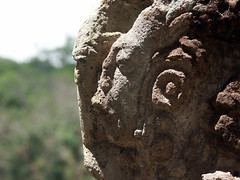
Ninety-five percent of Mexico remains essentially unexplored.
David Grove, a professor emeritus of anthropology at the University of Illinois at Urbana-Champaign, who has worked in central Mexico for more than 40 years, as reported by National Geographic in Ancient City Found in Mexico; Shows Olmec Influence
And that which has been found is being eaten by acid rain.
oreo
This is an attempt at a black and white center with the black form acting like a shadow and trying to be like white, which it is.
A caption from a drawing of the same title by Richard Tuttle, now on display at the MCA in Chicago
Monday, January 29, 2007
the second leg
a found poem
He entered the second leg unknown
and left it as a winner
nearly forgotten
the indelible image of Saturday's race
was of Barbaro coming up lame
Bernardini trapped the pace-setting Like Now
and Sweetnorthernsaint in the far turn
and made a powerful move at the top of the turn
to push ahead by three and a half lengths
I had plenty of horse
At the quarter pole
When I asked him
He took off
As [he] galloped down the backstretch
[Castellano] looked for Barbaro
saw that Prado had dismounted
and knew
something was terribly wrong
Found in Charge to Victory Unnoticed in Wake of Injury which ran in the New York Times right after the race horse Barbaro fell lame in the second leg of the Triple Crown. Today, after many months of limping recovery, Barbaro was put down.
He entered the second leg unknown
and left it as a winner
nearly forgotten
the indelible image of Saturday's race
was of Barbaro coming up lame
Bernardini trapped the pace-setting Like Now
and Sweetnorthernsaint in the far turn
and made a powerful move at the top of the turn
to push ahead by three and a half lengths
I had plenty of horse
At the quarter pole
When I asked him
He took off
As [he] galloped down the backstretch
[Castellano] looked for Barbaro
saw that Prado had dismounted
and knew
something was terribly wrong
Found in Charge to Victory Unnoticed in Wake of Injury which ran in the New York Times right after the race horse Barbaro fell lame in the second leg of the Triple Crown. Today, after many months of limping recovery, Barbaro was put down.
Vanya: A Tale of Two Temperaments
It’s quite different to design a set than to design a building. It is the development of the metaphor that makes it so difficult. The level of abstraction is not generally what you focus on when you are designing a building. In my work I’m trying to solve very real problems. The subtle messages and meaning are probably more important to me and less important to my client. Here, all of that is terribly important.
~ Architect Leigh Breslau commenting on the work of designing the set for Uncle Vanya in the program for the show.
For all of my obsession on the deep, dark and ugly in people – and death, don’t forget the obsession with death – I’m largely an optimist. Okay: a cynical optimist. Left to their own devices I expect folks to flounder and flop awhile and then right themselves on a reasonable course of action.
I have reason to believe that this is not the case for my darlin’companion. He’s told me as much. He has little faith in people – he wholly expects that they’ll do things badly, if at all, and the whole thing will be a wreck as a result.
This is a frequent topic of conversation between us – frequently, if surprisingly, conducted in a light-hearted tone – but I suspect it pains him deeply, this conviction that people are mostly in it for their own gain, that they will hurt others along the way to get what they want, and that wreck and ruin is really all we have to look forward to.
Which might explain our dramatic tastes. I like it dark – if I had to pick a favorite play (please don’t make me pick – there are too many) it would Anouilh’s Antigone – and he prefers the Disney Channel. Prefers to watch the same movie repeatedly, actually, if he can be sure that he’ll be happy with the result. Lindsay Lohan’s remake of the Parent Trap was recently in the loop. (Full disclosure: the ending makes me cry too.)
And I love him for that. He’ll do dark with me, but that doesn’t mean he has to like it.
Emerging from the Court Theatre’s production of Uncle Vanya at the Museum of Contemporary Art in Chicago yesterday and I was all amped up, ready to talk about the wreck and ruin of it, the existentialist call for ACTION as the only possible antidote to all this bitter boredom and horrid self-centeredness – the way the cast – and a particularly strong Astrov played by Timothy Edward Kane -- called all that ennui out and raged futilely against it, trying to find their way to insurrection and failing utterly, finally, at the end to do anything but survive it. Barely.
I wanted to talk about how the spare sets, designed by architect Leigh Breslau, presented such a brilliant platform on which to play the play – the way it elevated scenes and frequently left the players suspended over nothingness – because really, wasn’t that what they were battling all the while anyway?
But no: the d.c. would have none of that. He didn’t like it. Didn’t want to talk about it. The whole lot of them were whiners. Not a redeeming one in the bunch. Yes: life is largely miserable, but there will be NO WHINING.
So let’s go home already. And turn on the TV.
The Court Theatre’s Uncle Vanya is playing through February 11th at the Museum of Contemporary Art in Chicago.
Here's the Metromix review »
And here's Mamet and Malle's transcendent take on the Chekhov play »
Sunday, January 28, 2007
contaminant
We are living in a modern world, and in contemporary music the central fact is contamination, not the contamination of disease but the contamination of musical styles.
If you find this in me, that is good.
Ennio Morricone in The Maestro of Spaghetti Westerns Takes a Bow in today's New York Times.
Later in the piece it's mentioned that: "For the beginning of Once Upon a Time in the West he persuaded the director, Mr. Leone, not to use conventional instruments at all: just amplified ambient sounds, from the creak of a swinging sign to the screech of an arriving train.
"Mr. Morricone is wary of having too much music in a film. 'It’s useless,' he said. 'After a while the audience loses track, and you cannot appreciate the psychological idea and aim that the music has.'"
Labels:
ennio morricone,
film,
live performance,
movies,
quote
ladies who lunch
Chicago matrons enjoy a spot of lunch at the Museum of Contemporary Art, surrounded by pink wallpaper peppered with large eyeballs.
Posting by cameraphone from the MCA
Posting by cameraphone from the MCA
guatemalan solidarity network
Patrick over at the Guatemalan Solidarity Network said some very kind things about my Guatemala posts and pix -- which of course left me quite pleased and blushing -- but even better than the ego boost was finding his blog which is loaded with relevant info about the current situation in Guatemala.
This from a recent post entitled Accompanying in Guatemala: Life in the Time of Sadness:
From their blurb:
The Guatemalan Solidarity Network -- check it out »
This from a recent post entitled Accompanying in Guatemala: Life in the Time of Sadness:
A few weeks ago, a boy who lived near us in Ilom suddenly passed away one morning. His mother and neighbors calmly explained that he had died of sadness. His father had left the day before to the United States out of economic desperation, and his departure had been absolutely devastating for the boy – to the extent that he never woke up.
Death by emotion is not uncommon here. In listening to friends` recounting of the genocide, "susto" - fright - is often given as an explanation of loved ones' deaths following the actual army-led massacres: when they either lived enslaved on a nearby plantation or in their village under violent military occupation (as in the case of those from Ilom), and when they fled into the wilderness for the next 14 years, foraging for food, struggling to elude army search squads and taking cover from aerial bombardments (as in the case of those from Xix).
From their blurb:
The Guatemala Solidarity Network (GSN), based in the United Kingdom supports the people of Guatemala who continue to struggle for change after centuries of oppression, violence, racism and exploitation.
The Guatemalan Solidarity Network -- check it out »
Saturday, January 27, 2007
navel gazing

This carved chest contains one of the most sacred objects in Guatemala.
It’s suspended from the ceiling of a small room in a non-descript home – the Confraternity house of San Juan -- off a steep narrow alley in the town of Santiago Atitlan in Guatemala.
The box was carved by the artist Diego Chavéz, who also carved the altarpiece of Santiago Atitlan with his brother Nicholas. The other side of the box – the side I couldn’t see from where I was shyly standing and trying to take pictures without firing my flash -- contains an image of a woman giving birth. Inside is the sacred bundle of Yaxper: “patroness of the moon, weaving, childbirth and midwives, who participated in the creation of the world”.[1]
So perfectly appropriate that one of the creators of the world would be a crafty girl.
The Mayans have a long tradition of revering bundles – they appear in hieroglyphic inscriptions going back thousands of years. I don’t entirely understand what it is thought that they contain, but I know that this one matters more than most.

I’ll let Allen Christenson tell the story, because he understands what I saw in that room, under the sweet attentions that the confradia paid to Yaxper, better than I did:
The Yaxper bundle is called ruk’u’x alaniem (“heart of the placenta”) and consists of a small woven cloth with pendant ribbons and tassels which the head of the confraternity said represent umbilical cords and tendrils of plants.
The cloth itself symbolizes the inside of a woman, including the placenta. Three small angel faces are sewn onto the cloth which represent the “corn girls”. The cloth is used by midwives and shamans to aid in childbirth as well as in healing ceremonies for sick infants.
Following delivery, midwives often bring the placenta to the confraternity to be blessed. It is then wrapped in a cloth and buried, either at the edge of the mother’s hearth, or sent to be thrown into the lake.
Under the ribbons at the base of the cloth are two small, round, very hard cloth bags, which I was told contain dried lumps of maize dough. These are called the yuxa (“divine twins”), which [are associated] with the original placentas, or “seeds” of the human race; all things that have an umbilicus are linked to this womb-root.
The association of the placentas with the sacred bundle of the grandmotherly midwife deity Yaxper, which contains the original “seeds” of the human race, likely ties the Confraternity of San Juan with the house of Xmucane, grandmother of the Hero Twins in their aspect as maize deities.[2]
The ceiling of the room is decorated with the curling tendrils of plants – also thought to represent umbilical cords. As are the cords that the carved chest is suspended from.
All things that have an umbilicus are linked to this womb-root – the seeds of the human race.
Belly buttons, baby: they’re what bring us all together. A constant reminder of our common humanity.
I love that.

[1] Weaving the Fabric of the Cosmos by Allen J. Christenson
[2] Art and Society in a Highland Maya Community by Allen J. Christenson
Labels:
belly button,
crafty girls,
goddess of the moon,
guatemala,
mayan studies,
travel,
Yaxper
Friday, January 26, 2007
that's why I like him
Give me the artist who breathes it like a native, and goes about his work in it as quietly as a common man goes about his ordinary business. Mozart did so; and that is why I like him.
George Bernard Shaw on Mozart
self-portrait
petulant technology
The server understood the request, but is refusing to fulfill it.
The error message that I just received when I tried to retrieve a secure document with all the proper credentials.
search engine optimization as a contact sport
Billed as the "world's most prestigious SEO contest" (I suspect it may be the world's ONLY SEO contest), a marketing agency out of Sweden is running a competition to see who can score the highest search engine rank (known as SER to folks who care about these things -- and yes, full disclosure: I am one of those people) on the selected phrase: "globalwarming awareness2007".
The winner will be the domain that ranks highest across all the major search engines when the keyword phrase is queried on May 1st. Only domains registered after January 15th of this year qualify. Google SER will break any tie that might present itself.
It's not clear to me what prize will be awarded to the winner -- the glory of being able to claim that they've won the world'smost prestigious only SEO contest?
Oh wait -- forgive me -- there are prizes. Big prizes.
The contest sponsors are quick to point out that the keyword phrase "globalwarming awareness2007",was selected for its virtue. But I've gotta wonder: how virtuous is it to persuade folks to create content designed to jockey for top spots across the major search engines -- when that content will be abandoned after May 1st? Online content at its best is fresh and relevant -- junk at the top of the pile does nobody any good.
Call me old fashioned: but I think content creators have a social responsibility to create content that's worth something -- for everyone. Particularly the folks who are searching it out.
There's a group on Flickr called "tag whores" where folks post images with extending tagging -- usually whole phrases and sentences that act as extended captions. They're fun to read, and there are a few masters out there who tell some great stories that way (and admittedly I'm not blame-free from adding "tag spam" of my own) -- but the metadata-dominatrix in me gets queasy when I see folks messing with their metadata like that.
All the messy search results. All the lost searchers.
But I suppose it all evens out in the end. The exoskeleton of metadata that is tagging just becomes a little bit messier than anticipated -- the story just gets a little bit more complex.
The winner will be the domain that ranks highest across all the major search engines when the keyword phrase is queried on May 1st. Only domains registered after January 15th of this year qualify. Google SER will break any tie that might present itself.
It's not clear to me what prize will be awarded to the winner -- the glory of being able to claim that they've won the world's
Oh wait -- forgive me -- there are prizes. Big prizes.
The contest sponsors are quick to point out that the keyword phrase "globalwarming awareness2007",was selected for its virtue. But I've gotta wonder: how virtuous is it to persuade folks to create content designed to jockey for top spots across the major search engines -- when that content will be abandoned after May 1st? Online content at its best is fresh and relevant -- junk at the top of the pile does nobody any good.
Call me old fashioned: but I think content creators have a social responsibility to create content that's worth something -- for everyone. Particularly the folks who are searching it out.
There's a group on Flickr called "tag whores" where folks post images with extending tagging -- usually whole phrases and sentences that act as extended captions. They're fun to read, and there are a few masters out there who tell some great stories that way (and admittedly I'm not blame-free from adding "tag spam" of my own) -- but the metadata-dominatrix in me gets queasy when I see folks messing with their metadata like that.
All the messy search results. All the lost searchers.
But I suppose it all evens out in the end. The exoskeleton of metadata that is tagging just becomes a little bit messier than anticipated -- the story just gets a little bit more complex.
Thursday, January 25, 2007
for lolabola
When a dream clearly gives notice, "it shines, it glitters, in the blackness, in the early dawn."
Dennis Tedlock writing about the place of dreams in the Mayan worldview, and citing the Popol Vuh, in his introduction to his translation of the text.
A lot of curious things have been unfolding in my dreams and the dreams of my friends in recent days -- Lolobola regularly reminds me of the importance of listening to those dreams.
the backstrap loom

Before beginning her first weaving, a girl prays to a saint for assistance, lighting a candle and saying:
Look upon my poverty
Look upon my nakedness
Please
Give me three graces
Three battens
Three needles
So I may weave my blouse
So I may weave my skirt
So I may weave my shawl
As told in With their Hands and their Eyes: Mayan Textiles Mirrors of a Worldview
This woman was weaving with a backstrap loom in the back courtyard of her home -- I bought a beautiful traditional hand loomed skirt from her mother -- that was just about the length of the cloth that she's preparing here.
I realize the exposure is all goofy in this shot, but I wanted to give a sense of the scale of the piece she was working on.
on that note
Everything in the world is like music: how you dress, how you speak, architecture, furniture -- everything.
I like to listen to how people talk -- what they choose to talk about, the pacing of their voice, how they build up to what they're saying. People's voices are very musical in conversations, what they [say] for emphasis.
Wynton Marsalis
tiny bubbles

DWR is asking folks to vote in this year's annual Champagne Chair contest -- click here to weigh in »
Tuesday, January 23, 2007
speaking of pasties
January's not yet in the can but I don't care -- this Google query wins the "most interesting traffic driver to detritus" of the month award -- nobody's going to top it. It reads:
(Could it be litwit, looking to diversify her work experience, now that she's made her move to NYC?)
is business license required for dominatrix business in nyc
(Could it be litwit, looking to diversify her work experience, now that she's made her move to NYC?)
security revue (if.)
If I were a performance artist I would buy an open jaws airline ticket and travel to all the airports in the United States where, while going through security, I would strip down slowly and decorously, stacking my clothing in the little grey bins, until only the barest undergarments remained -- sparkling silver pasties and a matching g-string might do. This is performance art, after all.
Once through the metal detector I would dress again and board my flight.
All of this TO MAKE A POINT.
(Yes, clearly, all this travel is taking its toll.)
Once through the metal detector I would dress again and board my flight.
All of this TO MAKE A POINT.
(Yes, clearly, all this travel is taking its toll.)
built chicago

Feeling like the popular girl today: received a note from the editor of BuiltChicago.com, a website "dedicated to architecture, planning, and real estate in the Second City", to let me know that my photo of the University of Chicago's Reg Library was featured as the photo of the day.
More important than my bloated ego (and decidedly more interesting) is the correlate Chicago architecture wiki project that Built Chicago is running.
It's young yet -- the "all existing pages" index is brief (not at all in keeping with we windy city types [1]) -- but oh, the places we'll go.
All it's gonna take is a few architecture freaks to get all wiki-with-it. Consider this your engraved invitation, folks.
[1] Rumor has it that the "Windy City" nomiker has little to do with the gusts that blow off Lake Michigan, and much to do with the tendency of Chicago politicians (and maybe bloggers?) to go off at length about anything at all.
right in the kisser
Internet video is the new baby kisser.
NPR reporter Robert Smith, reporting this morning on how U.S. political candidates are using online video to control context and avoid press conferences.
tempus fugit
a found poem
The collected clocks of the solar system
are a meager sampling
Far more is going on
in the subatomic community
events occurring in increments
far briefer than classic quickies
like “in a heartbeat”[1]
or “in the blink of an eye”[2]
Intervals like the attosecond [3]
the zeptosecond [4]
the yoctosecond [5]
The fundamental quivers of the atom
are exceedingly regular
they mark the heartbeat of the universe
Our beloved second
(a fraction of a solar day)
is linked to oscillations
in a cesium atom
Poised between the extremities
and homogeneities
of nature
Between delirium and ad infinitum
Our andante tempo
may be the only pace open to us
Found in Making Sense of Time, Earthbound and Otherwise by Natalie Angier in the Science section of today’s New York Times.
[1] about a second
[2] a tenth of a second
[3] a millionth of a trillionth of a second or 10-18 second
[4] a billionth of a trillionth or 10-21 second
[5] a trillionth of a trillionth or 10-24 second
yamazaki's notebook
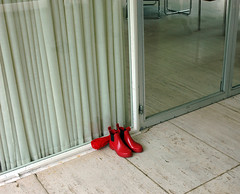
Building art is always the spatial expression of spiritual decisions.
Mies van der Rohe as cited by Flickrite Yamazaki in Meditations on a Book's Spine
Yamazaki, an Australian writer who has written for Blueprint Magazine, is kicking off a book publishing venture with a certain mindfulness that I suspect will result in extraordinary things. Yamazaki was gracious enough to use stills from my Farnsworth shoot in writing about the new venture.
While things are getting off the ground you might want to spend a little time at Yamazaki's Notebook (What Yamazaki Reads) -- a delightful blog that's sure to appeal to lovers of both books and architecture.
And why is it, I wonder, that those things so frequently go together?
Monday, January 22, 2007
the big four-oh

I hit 40 today. 40 pictures in Explore -- that mercurial algorithmic popularity engine that logs the top 500 "most interesting" images for the day.
For months I've hovered in the mid-30s, pretty sure that I'd never bust out. Who knows how long this will last: the Flickr gods are fickle, and may drop any image at any time for reasons that only they understand, and I'll be back in the 30s again -- or even the 20s.
But tonight -- as if Anne's sweet comment wasn't enough to make me glad I'm posting these pics even on days when I think they're no good and nobody's noticing -- I can proudly say that I am over the hill.
Sure, yeah, 40 is definitely only middle-weight -- and I feel silly that it makes me so happy -- but it does. And it may be the last time in my life that 40 feels this good.
So who said today was the saddest day of the year [1]? Not around here, baby -- not around here.
(And no, thank you, my mathetically-minded friends -- I don't need you to calculate the ratio of images uploaded to appearances in Explore -- just let me enjoy this for a little while first, please. ;)
Here's the run down, as graciously auto-generated by Flagrant Disregard's Scout utility:
1. street paints, 2. Miracle Car Wash, 3. Inland in Autumn, 4. thank you, mr. sugimoto, 5. he promised to return; she waited., 6. beware of dog, 7. no quarter, 8. Mies' Farnsworth House,
9. miesian time, 10. goldberg's garage, 11. vegas, baby, vegas!, 12. letter g, 13. lantern festival, 14. metra seat, 15. cameraphone drive-by, 16. in passing, ii,
17. the reg, 18. spaces within, 19. class in crown hall, 20. hellas blue #3, 21. do over, 22. wright's pump, 23. senior crossing, 24. mexico city p.o.,
25. the brillig sleeps, 26. Yixing, 27. Untitled, 28. crossing over, 29. Untitled, 30. On this Day, 31. empty gesture, 32. grandmother in esquipulas,
33. solo rio, 34. bluebird, 35. Untitled, 36. Untitled, 37. las niñas, 38. Kyoto Geisha, 39. how many?, 40. Koolhaas' SPL
[1] Coulda sworn I heard something about that on the radio, but the only online reports I can find are for 2006 -- ah well, will update with solid info if I can.
Update: From anniemcq of Mommy's in a Timeout, a link to the most depressing day story on NPR -- thanks annie!
salty language
It's become so common that we don't even notice that it is a philosophical rumination rather than a direct imperative. It's a bit of a social dilemma. On the one hand, you do want the salt. On the other hand, you don't want to boss people around lightly.
So you split the difference by saying something that literally makes no sense while also conveying the message that you're not treating them like some kind of flunky.
Cognitive scientist Steven Pinker explicating the phrase: “If you think you could pass the salt, that would be great,” as cited in Of Thought and Metaphor in yesterday’s Toronto Star.
“We have to do two things with language. We've got to convey a message and we've got to negotiate what kind of social relationship we have with someone,” says Pinker.
Sunday, January 21, 2007
three girls on a wall
Shot at the Post-Classic Mayan site of Zaculeu in the Guatemalan Highlands. We may have been the only Norte Americanos there -- it's a popular picnic spot with the locals.
The setting is spectacular -- mountain peaks all around, blue skies above. Imagine finding ancient Greek ruins at Yosemite -- it was kind of like that.
Zaculeu, Guatemala
The setting is spectacular -- mountain peaks all around, blue skies above. Imagine finding ancient Greek ruins at Yosemite -- it was kind of like that.
Zaculeu, Guatemala
speaking of memory
Jenny Diski writes in the London Review of Books about overcoming a lifelong fear of spiders through the, in her words, stupidly titled Friendly Spiders Programme at the Zoological Society of London:
Jenny Diski writing in the London Review of Books' Diary in the 30 November 2006 issue.
A person who is not afraid of spiders is almost by definition someone who is not me. So it is uncanny (in a properly Freudian sense of that word) to observe myself without that fear. Someway in which I knew myself has vanished. It is slightly frightening not being frightened of spiders.
And then I wonder, why not get hypnotized out of all my anxieties and nervous habits, make everything awkward and resistant go away, so that I could become... well, nothing is the alarming image I have.
I can't picture what would be left after I had chipped off the difficulties.
Jenny Diski writing in the London Review of Books' Diary in the 30 November 2006 issue.
the interpretation of dreams

Recently I have had a preponderance of dreams regarding luggage.
In one dream I was in the hotel room that I was in fact occupying, sleeping without any pajama bottoms, which I was in fact doing, and someone came into my room and took all the pants from my luggage and closet -- leaving me with no pants to wear. Not even pajama bottoms. I had business meetings scheduled, and awoke wondering how I should conduct myself in a business meeting while wearing no bottoms.
Last night I dreamed that a tidal wave was about to hit the building where I was staying -- I felt vaguely responsible for the tidal wave somehow, but was largely intent on getting myself and my luggage out of its trajectory. I grabbed my bag and fled to the nearest hilltop, with many others, yet feeling wholly alone. I realized as I cleared the ridge that I had left my toothbrush back in the building I had just fled.
Just compiled a Flickr set of airport camerphone shots -- I suspect it'll grow some more in the days to come, with three more destinations planned for the next two weeks.
Saturday, January 20, 2007
stuck in the eternal present
What we've shown is that people with amnesia really are stuck in the present. They can't recall the past, and now it seems that they can't even imagine the future or indeed richly imagine even fictitious experiences.
Eleanor Maguire of the Wellcome Trust Centre for Neuroimaging at University College London as reported in the brief National Geographic news piece: Amnesia Destroys Imagination as Well as Memory, Study Finds
What are we if we aren't our memories? What can we become if we can't imagine it?
ceiba space

I love this unremarkable image for a couple of reasons: The central figure is a ceiba tree, the world tree or axis mundi in Mayan cosmology, which stands in the center of the Four Directions and is believed to lift up the sky. Its celestial correlate is the Milky Way, the Mayan highway to the heavens.
The power pole next to it is pure happenstance, of course, but it’s in the shape of the cross – a symbol that the Maya long used to represent the world tree (decorating it, as they still do in Chamula, with the flowering blossoms of the ceiba and the needles of the pine) – long before the Spanish arrived and introduced their cross, carrying the crucified Christ. They use it still today, in Catholic churches, where ancient Mayan belief and colonial religion come together in a fascinating amalgam.

While we were traveling in Guatemala we had the good fortune to see the ceiba flowering in Mixco Viejo, a remarkable highland site about two hours outside Guatemala City. I didn’t realize how remarkable the event was until I went digging for some background material on the ceiba as World Tree, and found this afterword by Linda Schele in Maya Cosmos, the book she co-authored with David Friedel and Joy Parker:
“It’s a ceiba,” I chirped and began looking for a branch low enough to see one of the blossoms up close.From Maya Cosmos: Three Thousand Years on the Shaman's Path…
What I saw stunned me, for in her hand [where she held a ceiba blossom] lay a perfect replica of the earflares worn by the Classic Maya kings. Suddenly I understood the full symbolism of so many of the things I had been studying for years. The kings dressed themselves as the Wakah-Chan Tree, although at the time I didn’t know it was also the Milky Way. The tzuk head on the trunk of the tree covered their loins, the branches with their white flowers bent down along their thighs, the double-headed elliptic snake rested in their arms, and the great bird Itzam-Yeh stood on their head.
I already knew as I stood under that young tree in Tikal that the kings were the human embodiment of the ceiba as the central axis of the world. As I stood there gazing at the flowers in Joyce’s hand, I also learned that the kings embodied the ceiba at the moment it flowers to yield the sak-nik-nal, the “white flowers,” that are the soul of human beings. As the tree flowers to reproduce itself, so the kings flowered to reproduce their world.
When I returned to Austin, I went to the Plant Resources Center of the University of Texas Herbarium and spoke to Dr. Carol Todzia about what I had seen. She helped me find out about the life cycle and natural history of the ceiba and exactly how unusual the little encounter was. Not only are ceibas so high that you usually can’t see the blossoms, I learned that they do not necessarily bloom every year. In fact, it can be as much as ten years between such flowerings. … The ceiba flowers in January through the first week or so of February. … The tree blossoms in the month just before Creation day on February 5, so that it was in flower when First Father raised it into the sky.

One more reason I love this image: the faint impression of the volcano Atitlan in the far distance. Shortly after I took this shot we hiked up a hill to the pilgrimage site of Dios Mundo, where new year offerings from the night before still lay smoldering, and the ancient stone head to which they were presented stood in alignment with the mountain and the ceiba in the distance.
All that, and plus I've just got a thing for trees.

Labels:
archaeology,
axis mundi,
ceiba,
dios mundo,
guatemala,
maya,
mayan studies,
travel,
world tree
dendracide
Wanna get rid of a tree? Copper sulfate.
The asshole on the train to remote parking at O'Hare, talking to his buddies about how he outsmarted the Forestry Division of Algonquin, IL, where he lives in the historic district, who tried to prevent him from removing an old, established tree from his property. "It just turned brown all of a sudden," he said, laughing.
F*cker.
Friday, January 19, 2007
tic tac sudoko
the man across the aisle
puzzles out his third sudoko
two packages of tic tacs lie
on his seatback tray
every few minutes
he reaches for one
now orange
then green
he will consume each
in its entirety
depleting the clattering plastic cases
before we land
puzzles out his third sudoko
two packages of tic tacs lie
on his seatback tray
every few minutes
he reaches for one
now orange
then green
he will consume each
in its entirety
depleting the clattering plastic cases
before we land
Thursday, January 18, 2007
coffee in a college town
You know you're in a college town when the cafe patrons find their seats *first* -- unloading their books and coats and gear -- before getting their coffee.
That, and there's always the geek chick in the corner who's expounding on something or other -- very loudly. (I love you, geek chick -- it's just that you're so predictable.)
Posting by cameraphone from a fair trade coffeehouse in Ann Arbor, Michigan. Little too much traveling this week.
That, and there's always the geek chick in the corner who's expounding on something or other -- very loudly. (I love you, geek chick -- it's just that you're so predictable.)
Posting by cameraphone from a fair trade coffeehouse in Ann Arbor, Michigan. Little too much traveling this week.
Wednesday, January 17, 2007
lincoln monument drive-by
Sure it's a good thing when the meeting runs two hours over because everyone's loving each other so much and cooking up new ideas -- but did it HAVE to happen on such a beautiful day? In one of the most well-appointed cities in the world? When there are so many gorgeous things to shoot? And my flight is leaving so frickin' early?
Dang.
Posting by cameraphone from Washington D.C.
Dang.
Posting by cameraphone from Washington D.C.
adriá's armada
One "gastronomic interpreter" provided by the Spanish government Two people whose sole job is to sweep the stones in the driveway 49 kitchen staff Additional staff of photographers and graphic designers "who often do nothing but document his every move in the kitchen"
Spanish chef Ferran Adriá's support crew, as detailed by Andrew Zimmern in Northwest Airlines January in-flight magazine. Adria is the father of "molecular gastronomy".
oculus
Fill in the blank: "The single oculus, which causes the prisoner's gaze to..."
-- From Foucault's Discipline & Punish
Posting by cameraphone from Reagan National in Washington DC (where I can't get to my bookshelves).
-- From Foucault's Discipline & Punish
Posting by cameraphone from Reagan National in Washington DC (where I can't get to my bookshelves).
Tuesday, January 16, 2007
he filed
Just heard on the radio that Barack Obama has filed the necessary paperwork to consider a run for the White House. Final decision to come on February 10th.
Update: here's his statement »
Update: here's his statement »
high culture
There was a government official in Guatemala some years back who decided that Guatemala needed a little "classical culture" -- so he built Roman temples to Minerva in all the big cities.
This isn't one of them -- it's a theatre in the heart of Xela -- but it reminded me of the story.
Guess 5,000 years of Mayan culture -- with its art, architecture, writing system, calendar, and concept of zero way before anybody else figured that one out -- just didn't do it for him.
This isn't one of them -- it's a theatre in the heart of Xela -- but it reminded me of the story.
Guess 5,000 years of Mayan culture -- with its art, architecture, writing system, calendar, and concept of zero way before anybody else figured that one out -- just didn't do it for him.
Monday, January 15, 2007
Ik'y

I’m an oaf. It's always been that way. You could call it clumsy, but I’m not sure it’s that. Back when I was young and lithe (oh to be young and lithe again…) folks would ask me if I was a dancer or a model. Once, when I said no, one fellow said: “Huh. You move like one.” He might have had ulterior motives, but the point is: mine is a curious kind of clumsy.
I used to chalk it up to a tall girl thing [1] – at 5 foot 12, I’m not built to the same scale as the rest of the world. But I manage to get through most days without tripping up too much. I’ve only been in one auto accident (if you don’t count the curbs that I’ve clipped) and then it was the other guy who sideswiped me in the early morning in a neighborhood intersection (later that day I told my grandmother about it: “Grama: I was in car accident this morning -- I was hit by priest.” Her voice soaked with concern, she wanted to know: “Oh Dayna dear: Was he drinking?” Grama’s a good Lutheran. She knows all about those priests.)
No: when I destroy something it’s usually sudden, startling, and forceful. And entirely unexpected. Never with malice aforethought, although my darlin’ companion has suggested it has something to do with a certain lack of awareness (thanks for the vote of confidence, dear).
Take tonight’s meatloaf incident. Buoyed by the success of Georgia’s Cabbage and Apple Salad I turned back to her cookbook to make the first meatloaf of my life last night (I figured if meatloaf was good enough for one of America’s preeminent modernist artists, it was good enough for me) – and, frankly, it wasn’t half bad. Tonight I warmed up the leftovers and – and here’s the crucial point – after we had eaten I left the glass Pyrex loaf pan on the front burner of the stove, to cool.
A little while later I put on the kettle to make some tea. Not the kettle that I summarily destroyed last spring – this is a new, as yet unscathed, kettle. But I made a mistake that I’ve made before with our &#~$%! stove – I turned on the front burner, thinking I was turning on the back burner.
And of course I turned it up high enough to boil the water in the kettle – the water that was in the kettle on the BACK burner.
I stepped into the living room where I can still hear the kettle doing its thing, but very soon the sounds from the kitchen became very un-kettle-like. Bubbling and gurgling – not hissing and boiling and whistling. I stepped into the kitchen to find the glass loaf pan cooking on a red hot burner.
Hmmm.
I turned off the burner. This was the correct thing to do. And then I did something that I shouldn’t have done: I lifted the loaf pan (with oven mitts, of course) and set it on a wooden cutting board that was perched over the sink.
Just as I set it down I thought to myself: “This probably isn’t the best thing to do.” And as I stood there in my mitts, studying the situation, the pan exploded with a brilliant bang.
Glass shrapnel flew everywhere. Boom, clatter, bang.
The beautiful thing was that I was in a position to witness the whole event.
Later, as I was picking a piece of glass out of my middle toe, I realized that it was pure good luck that a piece hadn’t flown up into my eye. It took me about an hour to clean up the whole mess and wash all the dishes that had been exposed and sift under cabinets and down drain pipes to get every last piece.
But here’s the thing: It was beautiful. And exhilarating. My only anxiety was attached to my darlin’ companion’s reaction to the mess (he's a tidy soul and I suspect that my inclination towards messiness makes him a little bit crazy) – and so I immediately shouted – as I have on so many other occasions where something not unlike this has occurred – “don’t come into the kitchen! I’ll take care of it!”
Another important point: This kind of destruction occurs in my life with some frequency. Despite my best efforts it's not uncommon for things to explode or otherwise self-destruct under my influence.
While sweeping up the chaos I flashed to a conversation that I had in Guatemala with some friends. We were talking about the plausibility of our Mayan horoscopes – they’re determined according to the Mayan calendar, so they take into account not only the month and day on which an individual is born, but also the year. My sign is the Ik’ – the North Wind – which is one of four days, or Mams, on which a new year may begin.
It’s a forceful sign -- and violent. It represents “wind, breath, life, one’s spirit” – a little like the Chinese idea of Ch’i. “Imaginative, physically strong, dreamers. A child born on Ik’ will be a bravo, strong, wild, even violent person”. Of course I took exception to the violent part. Me? Violent? I wouldn’t hurt a flea. When the truth is: I wouldn’t mean to hurt a flea. But of course it’s my nature, like Steinbeck’s Lenny, to squash it flat before I realize I’ve killed it.
And of course I’ve done the same thing with words, to friends, and to family, before I realize the damage I’ve inflicted and can’t revoke, goddammit.
Ik’ is the wind that precedes the rainstorm, kicking up the clouds and shaking down the trees. If you’ve ever been in Boulder, Colorado in the summertime at about 4 o’clock in the afternoon, you know exactly what I mean.
And Ik’, I learned tonight, can be Pyrex -- cooked past its tolerance, shattering in a furious storm of light and noise, scattering diamonds of glass across the tiles.
[1] heatherlorin's posted some great tall girl stuff over at mixed bag recently »
moments when the light

There are moments when the light
Makes me start up, fright
In my heart as if I feared to see
Unbearable clarity about me.
Once, on Portobello Bridge,
I had the sudden privilege
Of seeing light leap from the sky
About five o’clock on an autumn day,
Defining every visible thing,
Unseen by one among the moving throng;
Road, bridge, factory, canal,
Stained swans and filthy reeds, all
The set homegoing faces
Filling motorcars and buses;
Then I knew that energy is but
Unconsciousness; if moving men could
See where they are going, they would
Stop and contemplate the light
And never move again until
They understood why it should spill
A sudden benediction on
The head of every homegoing man.
But no one looked or saw the way
The waters danced for the visiting light
Or how green foliage glittered. It
Was ignored completely.
I knew the world is most at ease
With acceptable insanities,
Important nothings that command
The heart and mind of busy men
Who, had they seen it, might have praised
The light on Portobello Bridge.
But then, light broke. I looked. An evening glow.
Men go home because they do not know.
Brendan Kennelly in A Time for Voices
happy birthday, martin.
Our lives begin to end the day we become silent about things that matter.
Martin Luther King Jr.
Sunday, January 14, 2007
appassionato
I found out that my passion is not so much for music. My passion is for people.
Yo-Yo Ma on NPR this morning
georgia's cabbage salad
I’ve been moping around since my Green Earth fresh veggie supply dried up and I had to go back to the flaccid line up in the grocery store.
It’s not so much that it’s bad produce – it’s just not the same kind of growing green and alive produce that showed up every couple of weeks during the summer. The Green Earth stuff was so fresh that it would off-gas in my crisper drawer – I’d find condensation droplets collected on the glass roof of the bin.
I thought maybe the problem was my own lack of imagination – maybe I was caught in a broccoli rut. The trip to Guatemala only compounded the problem, because of course the only produce served down there was seasonal and grown locally -- my first encounter with a Chicago winterized tomato nearly spun me into a depression. So this last week I went digging for something uniquely winter-like -- and came up with something that just might get me through to Spring.
Not too complicated, maybe so simple that you’ve seen it before -- this one did the trick for me last night. It’s like all the recipes from A Painter’s Kitchen -- a compilation of the recipes that Georgia O’Keefe served up at Ghost Ranch -- very few ingredients are required -- what matters most is careful attention to the details of its preparation.
Freely adapted from A Painter’s Kitchen: Recipes from the kitchen of Georgia O’Keefe
It’s not so much that it’s bad produce – it’s just not the same kind of growing green and alive produce that showed up every couple of weeks during the summer. The Green Earth stuff was so fresh that it would off-gas in my crisper drawer – I’d find condensation droplets collected on the glass roof of the bin.
I thought maybe the problem was my own lack of imagination – maybe I was caught in a broccoli rut. The trip to Guatemala only compounded the problem, because of course the only produce served down there was seasonal and grown locally -- my first encounter with a Chicago winterized tomato nearly spun me into a depression. So this last week I went digging for something uniquely winter-like -- and came up with something that just might get me through to Spring.
Not too complicated, maybe so simple that you’ve seen it before -- this one did the trick for me last night. It’s like all the recipes from A Painter’s Kitchen -- a compilation of the recipes that Georgia O’Keefe served up at Ghost Ranch -- very few ingredients are required -- what matters most is careful attention to the details of its preparation.
Cabbage Salad with Apple andWalnutsPecans
½ small green or red cabbage (I used green)
1 small apple with a sweet and tart flavor
½ cupwalnutspecans (I don’t like walnuts so much)Herb salad dressingThe recipe for the mustard-based dressing shows up earlier in the book, but you could use your favorite and it would work well here. I followed the advice of the intro accompanying the recipe and threw in a little Greek yogurt instead.
Halve and core the cabbage half. Slice into fine shreds – no wider than 1/8 inch and no longer than 2 inches. Slice the apple into chunks about ¼ inch thick and a ½ inch square. (If the apple isn’t organic you may want to skin that bitter peel off first.) Break the pecans up so they’re about the same size as the apple pieces.
Toss the cabbage, apple and pecan pieces together. In a side dish, mix together the yogurt – best if it’s Greek and whole fat (I used FAGE Total Classic) with a splash of lemon juice.
Once that’s where you like it, mix it in with that perky eat-me-now-I’m-so-crisp-and-lovely sliced goodness that you mixed up in the other bowl.
Serves 4 to 6.
Freely adapted from A Painter’s Kitchen: Recipes from the kitchen of Georgia O’Keefe
all the names are already taken
I'm not sure how I missed Tous les noms sont déjà pris... pfff...'s Flickr photostream all this while -- and now that I've found it I'm not entirely sure that I understand it -- but I think that's okay.
Because something extraordinary (and a little bit strange) is going on over there »
p.s. for all you travelers out there: he's looking for Paris-based models.
Because something extraordinary (and a little bit strange) is going on over there »
p.s. for all you travelers out there: he's looking for Paris-based models.
Saturday, January 13, 2007
mitzvah
How beautiful you are, my darling! Oh, how beautiful!
Your eyes behind your veil are doves.
Your hair is like a flock of goats descending from Mount Gilead.
Your teeth are like a flock of sheep just shorn, coming up from the washing. Each has its twin; not one of them is alone.
Your lips are like a scarlet ribbon; your mouth is lovely.
Your two breasts are like two fawns, like twin fawns of a gazelle that browse among the lilies.
All beautiful you are, my darling; there is no flaw in you.
The Fourth Song of Songs, heard just now on the Re:Sound program Honoring the Body: Taharah. The song is recited by those who participate in the Jewish ritual washing of the dead to honor the individual whose body is being prepared for burial.
The Songs of Solomon have always struck me as a little too bordello-like and over the top -- but to hear them recited in this context -- over the body of the honored dead -- changed everything.
lady's pants
After my grandfather passed away my grandmother dated her old high school sweetheart for a little while. He was retired, but had traveled all over the world. I asked him what brought him to all those wonderful places, and he said, with a wry smile: "I was in lady's pants."
He manufactured and distributed blue jeans for women.
But he was also quite a player, so I really had to wonder...
He manufactured and distributed blue jeans for women.
But he was also quite a player, so I really had to wonder...
luminous lumiere
One more reason to love Flickr: The things folks pull out of their back rooms and closets to share.
This from embleton, whose posts from London are always extraordinary, quirky and uniquely oneirical:
This from embleton, whose posts from London are always extraordinary, quirky and uniquely oneirical:
Lumiere Brothers Autochrome Glass Plate c. 1907
Taken by my great-grandfather.
The autochrome plates were the invention of Auguste and Louis Lumiere, who patented the process in 1904 and began to market it commercially in 1907. The process provided the first widely available form of colour photography.
Microscopic grains of potato starch were dyed red, green, and blue-violet, then mixed evenly and coated onto a sheet of glass. A black-and-white emulsion was then flowed over this layer. During exposure, the grains of potato starch on each plate acted as millions of tiny filters. The light-sensitive emulsion was then reversal processed into a positive transparency.
When viewed, light passes through the emulsion and is filtered to the proper color by the starch grains. The resulting mosaic of glowing dots on glass gives autochromes the look of pointillist paintings.
The plates came in a range of sizes. These are 16.5cm by 12cm so sadly get cropped by my scanner.
Friday, January 12, 2007
fondling the calabash

In the Popol Vuh, The Mayan Book of the Dawn of Life and the Glories of Gods and Kings, the severed head of One Hunahpuh, one of the Hero Twins, winds up in a calabash tree (long story) -- a position which he uses to full advantage when the lovely maiden Blood Moon stops by. He spits in her hand, subsequently impregnating her with twins -- and so our story begins again.
(Being one with a point to make, Hunahpu explains as his spit finds its mark that now the father's face will survive his son, even after his own face has rotted away and left nothing but bone.)
It's a great read. Honest.
Labels:
archaeology,
books,
guatemala,
mayan studies,
mythology
Thursday, January 11, 2007
a faith more profound
a found poem
It might charm them
Or be used by them
It can reveal more than they know
Offering secrets
Or promising salvation
Despite all expectations
[Music] can shock
With its revelations
Found in « Hitchcock, Thrilling the Ears as Well as the Eyes » in the 8 Jan edition of the New York Times.
It might charm them
Or be used by them
It can reveal more than they know
Offering secrets
Or promising salvation
Despite all expectations
[Music] can shock
With its revelations
Found in « Hitchcock, Thrilling the Ears as Well as the Eyes » in the 8 Jan edition of the New York Times.
Wednesday, January 10, 2007
time to exhale
Ever hold your breath so long that you don't realize you're holding it -- except maybe for the fact that you're blue in the face and your chest is starting to ache. And then all of a sudden the reason you're holding it is resolved and you find yourself taking a deep, welcome breath of fresh air?
The BHOTW's home after a very long time away in a very scary place where folks were (are) regularly losing their tempers and doing erratic things with munitions. Or so they keep reporting on the news.
Welcome home, friend.
And thanks. I needed that.
The BHOTW's home after a very long time away in a very scary place where folks were (are) regularly losing their tempers and doing erratic things with munitions. Or so they keep reporting on the news.
Welcome home, friend.
And thanks. I needed that.
smoke gets in my eyes

Little mother when I die
Bury me beneath your hearth
And when you're making tortillas
Cry for me
And if they ask you, little mother
Why are you crying
Tell them my firewood is green
And the smoke gets in my eyes
~ Traditional Nahuatl (Aztec) poem as told by Nick Hopkins
In the ancient Mayan and Aztec traditions, as in many places in the ancient Middle East, the family buried their dead beneath the floor of their home, so that the ancestors would remain close where they could be cared for and from where they might influence future proceedings.
secure advertising
It creates a cleaner, smoother, more professional process.
TSA Spokesperson Ellen Howe commenting on the TSA's decision to allow advertisers to run ads in the bottom of those little airport security bins -- the ones used in airports for funneling shoes and coats and laptops through the xray devices -- in exchange for providing new bins, carts and stainless steel tables to the airport. As reported on the front page of today's USA Today.
Anyone remotely associated with a business driven by advertising dollars can tell you why this is a bad idea -- just as anyone who's passed through security at the airport can tell you that the clusterfoo that is airport security post 9/11 needs the attention of efficiency experts so that it can be redesigned to swiftly move folks through who are in various states of undress and disembowelment.
If the ad guys get in on the act there's no good reason to straighten out the mess because long waits means longer exposure to the ads.
We might even see acts of subterfuge designed to further snarl things up and further compound the wait time -- much the same way that placing the dairy case at the back of the grocery store ensures that folks who want to buy a gallon of milk will take a little longer to make their purchase, spend more time in the store, and spend a little more money.
But of course the airports stand to make millions from this promotional technique, so we can expect to see it implemented soon and without a lot of fuss.
Tuesday, January 09, 2007
so this is south dakota
Or Minnesota, maybe.
Somewhere between Sioux Falls, SD and Marshall, MN.
Are we there yet?
Somewhere between Sioux Falls, SD and Marshall, MN.
Are we there yet?
Monday, January 08, 2007
stigmata

In the tiny museum snugged away in the inner courtyard of the Cathedral of Guatemala City there's a small room in the back that features framed scraps of cloth that appear to capture the impression of stigmata.
We found the room just as the guards were ordering us out, so I only had time to snap this one shot -- which I regret, because the many impressions were varied and various. Roses, crosses and other iconography were scattered in among more crowns of thorns like these.
I didn't have time to read the placards that accompanied the exhibit, but my darlin' companion did: he said they weren't stigmata blottings at all, but were ascribed as miracles to a nun who would touch the cloth, and in the morning these bloody impressions would be found to dot the muslin.
It reminded me of the outsider art of that fellow who created whole canvases with the spit from his tobacco chaw.
oneirical vision

The nets are here transformed into a oneirical vision, a perceptive exploration to unveil the complexity concealed behind the reality.
From the English Translation of a brochure accompanying Istos, an exhibition of works by the Italian photographer Massimillano Lattanzi, now showing at the National Gallery of Modern Art in Guatemala City
Oneirical is a curious translation of the french onirique, which according to a definition that I pulled off Google (define: onirique) means "relatif aux rêves, qui rappelle un rêve ou qui est inspiré par le rêve" -- or as sloppily translated by Bablefish: "Relating to the dreams, which points out a dream or which is inspired by the dream".
This is a new one for me -- at first I thought they were going for "unique" and then wondered (somewhat sheepishly) if they weren't talking about "onanism". Wikitionary spits up an instance of the word as "oneiric," which I suppose will have to do.
The closest word I can think of in English common usage would be "reverie", but that doesn't quite do it, does it? It doesn't have that delicious sense of something unique and vision-like -- it describes instead a driftless dreamer, not one who listens to dreams.
Sunday, January 07, 2007
Saturday, January 06, 2007
hammering nails

I haven't been gone all that long, but the visit to Target today -- to load up on laundry soap and other household essentials -- took my breath away.
The abundance. The clean sparkling shelves.
This boy is hammering nails. Used and bent nails. To make them straight again, to sell in the market or on the street.
Taken two weeks ago in Guatemala City, a short plane ride from Chicago, but miles removed from all that we have, all that we use without gratitude, all that we discard.
simple pleasures
A. Toilets with seats. Brushing your teeth with water from the sink. Flushing paper down the can (rather than placing it in a wastebasket).
Central heating. In the dead of winter. At 8,000 feet.
Q. What are things you don't realize bring you indescribable delight until you go without them for two weeks?
Central heating. In the dead of winter. At 8,000 feet.
Q. What are things you don't realize bring you indescribable delight until you go without them for two weeks?
on the flight home
across the aisle from me
a man reads
the chapter is headed
La Muerte
his thumb strokes
each line of type
with gentle patience
his eye traces each curve
a man reads
the chapter is headed
La Muerte
his thumb strokes
each line of type
with gentle patience
his eye traces each curve
Wednesday, January 03, 2007
mannish shoes
Stubby feet courtesy of my Irish grandfather; unlikely 6 foot frame to which they're attached compliments of the Norwegians on my grandmother's side; 500 year old stucco on which they both rest courtesy of Guatemala's post-classic Maya.
Iximché, just outside of Antigua, Guatemala.
Iximché, just outside of Antigua, Guatemala.
Subscribe to:
Posts (Atom)




